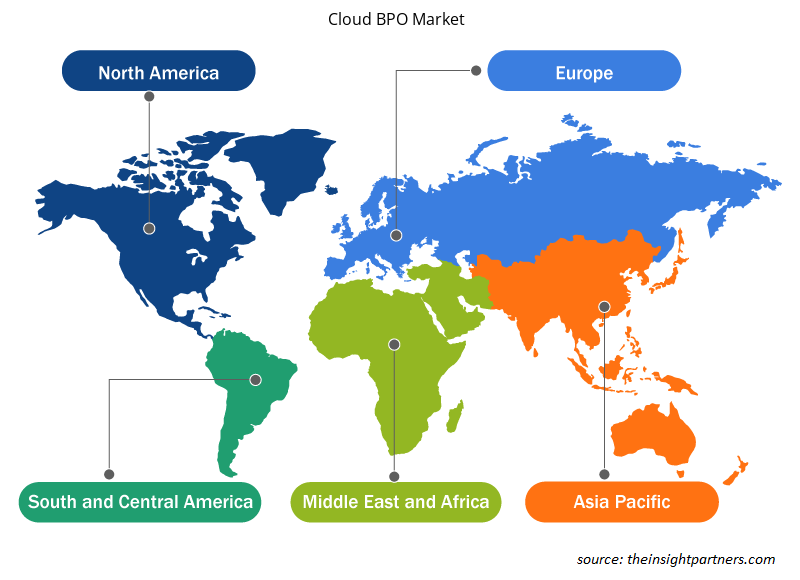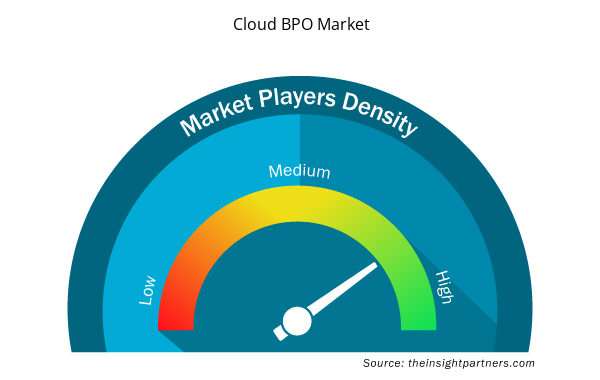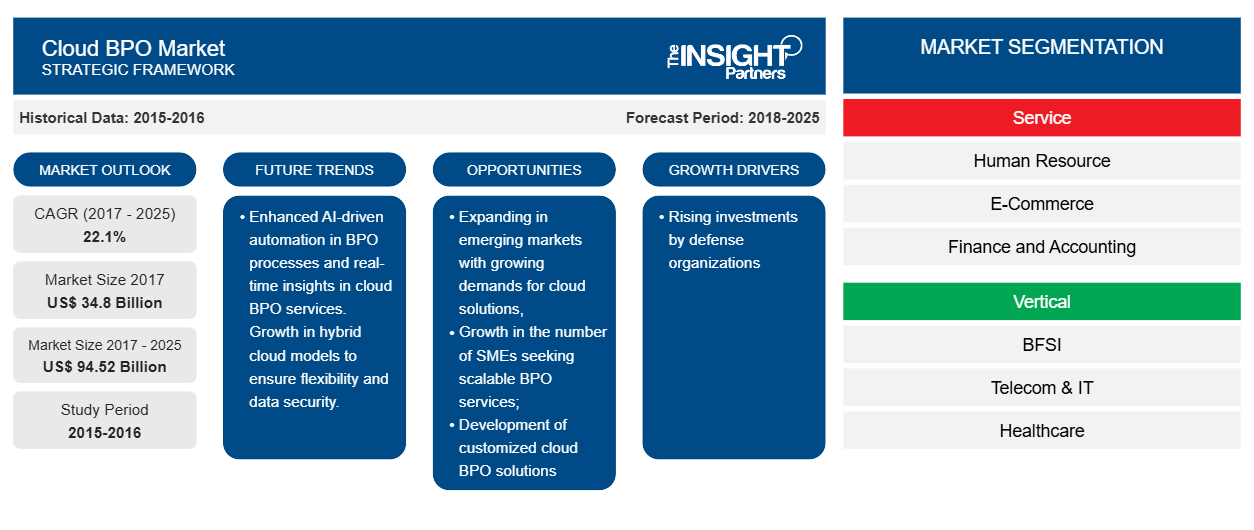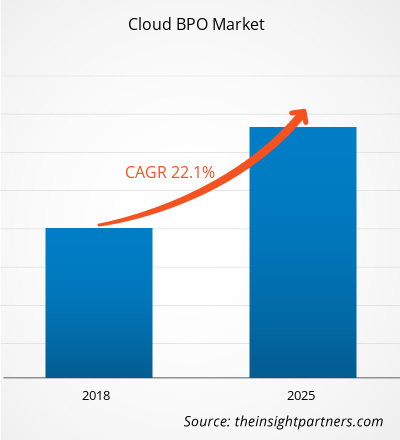Si prevede che il mercato del cloud BPO crescerà da 34.801,2 milioni di dollari nel 2017 a 94.522,7 milioni di dollari entro il 2025; si stima che crescerà a un CAGR del 22,1% dal 2017 al 2025.
La riduzione dei costi operativi e dell'agilità offerti dal Cloud BPO è attribuibile alla crescita del mercato. Il vantaggio in termini di costi offerto dal Cloud BPO è una delle ragioni principali che influenza la scelta delle organizzazioni rispetto ai tradizionali servizi BPO. Riduce drasticamente i costi IT dell'organizzazione fornendo supporto e manutenzione del software e dell'hardware, e inoltre aggiorna, aggiorna e gestisce senza sforzo i processi, portando successivamente a una riduzione dei costi dei servizi aziendali.
D'altro canto, un BPO stesso trae grandi benefici dall'integrazione del cloud computing. I fornitori di servizi BPO sono in grado di sfruttare i vantaggi del cloud computing riducendo i tempi di elaborazione per i processi aziendali ad alta intensità di dati delle organizzazioni e offrendo un flusso di lavoro di elaborazione dati in tempi di risposta ridotti. I Cloud BPO traggono grandi benefici anche in termini di flessibilità nell'aggiungere comodamente nuove funzioni e caratteristiche ai loro sistemi e soddisfare efficacemente le richieste in continua evoluzione dei clienti. Le piattaforme cloud forniscono ai BPO un'alternativa agile ed elastica eliminando la pressione della concorrenza imminente sul mercato. Grazie a questi vantaggi forniti dal Cloud BPO, le aziende di tutti i settori preferiscono esternalizzare i loro processi aziendali ai fornitori di servizi Cloud BPO, alimentando successivamente la crescita del mercato Cloud BPO a livello globale.
Personalizza questo report in base alle tue esigenze
Riceverai la personalizzazione gratuita di qualsiasi report, comprese parti di questo report, o analisi a livello nazionale, pacchetto dati Excel, oltre a usufruire di grandi offerte e sconti per start-up e università
- Scopri le principali tendenze di mercato in questo rapporto.Questo campione GRATUITO includerà analisi di dati che spaziano dalle tendenze di mercato alle stime e alle previsioni.
Approfondimenti di mercato–
Mercato BPO cloud
Obbligo di migliorare il servizio al cliente
I clienti nell'ambiente altamente competitivo odierno sono ben consapevoli del loro crescente potere e valore poiché hanno incontrato l'economia digitale e ottenuto l'accesso a vari servizi in tutto il mondo. Ciò ha ulteriormente aumentato le loro aspettative rispetto ai servizi basati su cloud poiché le organizzazioni sono diventate più consapevoli dei vantaggi dei servizi Cloud BPO. Il cloud come piattaforma di base è già stato sfruttato dai clienti come una nuova iniziativa esterna e interna, che ha successivamente aumentato la concorrenza tra i fornitori di servizi BPO, motivandoli ulteriormente ad adottare tecnologie improvvisate come le tecnologie basate su cloud per servire i loro clienti/clienti in un modo migliore.BPO services. The cloud as a core platform has been already been leveraged by the clients as a novel external as well as internal initiative, which has subsequently increased the competition among the BPO service providers, further motivating them to adopt improvised technologies such as cloud based technologies to serve their customers/clients in a better way.
Approfondimenti basati sui servizi
In base ai servizi, il mercato BPO cloud è segmentato in risorse umane, e-commerce, finanza e contabilità, assistenza clienti, vendite e marketing, altri. Il segmento delle risorse umane ha detenuto la quota di mercato più grande nel 2016.
Gli operatori che operano nel mercato del cloud BPO si concentrano principalmente sullo sviluppo di prodotti avanzati ed efficienti.
- Nel 2017, IBM e Dream Payments estendono i servizi di pagamento sul cloud agli istituti finanziari statunitensi.
- Nel 2017, il gruppo CMA CGM sigla una partnership strategica con Infosys per accelerare la trasformazione dei suoi sistemi informativi.
Approfondimenti regionali sul mercato Cloud BPO
Le tendenze regionali e i fattori che influenzano il Cloud BPO Market durante il periodo di previsione sono stati ampiamente spiegati dagli analisti di Insight Partners. Questa sezione discute anche i segmenti e la geografia del Cloud BPO Market in Nord America, Europa, Asia Pacifico, Medio Oriente e Africa, e Sud e Centro America.

- Ottieni i dati specifici regionali per il mercato Cloud BPO
Ambito del rapporto di mercato Cloud BPO
| Attributo del report | Dettagli |
|---|---|
| Dimensioni del mercato nel 2017 | 34,8 miliardi di dollari USA |
| Dimensioni del mercato entro il 2025 | 94,52 miliardi di dollari USA |
| CAGR globale (2017-2025) | 22,1% |
| Dati storici | 2015-2016 |
| Periodo di previsione | 2018-2025 |
| Segmenti coperti | Per servizio
|
| Regioni e Paesi coperti | America del Nord
|
| Leader di mercato e profili aziendali chiave |
|
Densità degli attori del mercato: comprendere il suo impatto sulle dinamiche aziendali
Il mercato Cloud BPO Market sta crescendo rapidamente, spinto dalla crescente domanda degli utenti finali dovuta a fattori quali l'evoluzione delle preferenze dei consumatori, i progressi tecnologici e una maggiore consapevolezza dei vantaggi del prodotto. Con l'aumento della domanda, le aziende stanno ampliando le loro offerte, innovando per soddisfare le esigenze dei consumatori e capitalizzando sulle tendenze emergenti, il che alimenta ulteriormente la crescita del mercato.
La densità degli operatori di mercato si riferisce alla distribuzione di aziende o società che operano in un particolare mercato o settore. Indica quanti concorrenti (operatori di mercato) sono presenti in un dato spazio di mercato in relazione alle sue dimensioni o al valore di mercato totale.
Le principali aziende che operano nel mercato Cloud BPO sono:
- Società a responsabilità limitata
- Società anonima WNS (Holdings) Ltd.
- Società anonima
- Società controllata da HCL Technologies Ltd.
- Società anonima
Disclaimer : le aziende elencate sopra non sono classificate secondo un ordine particolare.

- Ottieni una panoramica dei principali attori del mercato Cloud BPO
Il mercato del cloud BPO è stato segmentato come segue:
Mercato Cloud BPO – per servizi
Mercato Cloud BPO – per verticale
- BFSI
- Telecomunicazioni e IT
- Assistenza sanitaria
- Automobilistico
- Produzione
- Cibo e bevande
- Potenza ed energia
- Elettronica di consumo
- Altri
Mercato Cloud BPO – per area geografica
America del Nord
- NOI
- Canada
- Messico
Europa
- Francia
- Germania
- Italia
- Spagna
- Regno Unito
Asia Pacifico (APAC)
- Giappone
- Cina
- Australia
- India
Medio Oriente e Africa (MEA)
- Arabia Saudita
- Emirati Arabi Uniti
- Sudafrica
America del Sud (SAM)
- Brasile
Mercato Cloud BPO – Profili aziendali
- Società IBM
- Società Oracle
- SAP SE
- HPE
- Cosciente
- Informazioni
- Accentura
- Consulenza Tata
- Sistema finanziario Sungard
- Wipro
- Historical Analysis (2 Years), Base Year, Forecast (7 Years) with CAGR
- PEST and SWOT Analysis
- Market Size Value / Volume - Global, Regional, Country
- Industry and Competitive Landscape
- Excel Dataset

Report Coverage
Revenue forecast, Company Analysis, Industry landscape, Growth factors, and Trends

Segment Covered
This text is related
to segments covered.

Regional Scope
North America, Europe, Asia Pacific, Middle East & Africa, South & Central America

Country Scope
This text is related
to country scope.
Frequently Asked Questions
The Human Resource Outsourcing services offered by the Cloud BPOs facilitate the organizations approach the core HRO needs while synergizing business objectives with resource utilization.
Surging demand for Cloud BPO is aligned with the progression in global market for Robotic Process Automation (RPA). The RPA with other digital disruptors comprise of digital labor and advanced software automation has a potential to drive the new generation of Cloud BPOs facilities that offer virtual workforce.
North America region holds the largest market share in the cloud BPO market, owing to rising demand from the public sector, mid-size banking, healthcare sector and financial service organizations. The cloud based outsourcing industry in the region has recently witnessed multiple merger & acquisitions, partnerships and reconstruction which makes the market to grow efficiently in North America.
Trends and growth analysis reports related to Technology, Media and Telecommunications : READ MORE..
The List of companies
1. Firstsource Solutions Ltd.
2. WNS (Holdings) Ltd.
3. Infosys Ltd.
4. HCL Technologies Ltd.
5. Genpact Ltd.
6. Capgemini SE
7. CA Inc.
8. Atos SE
9. Tata Consultancy Services Ltd.
10. DXC Technology Company
11. Sungard
12. Accenture PLC
13. ADP LLC
14. IBM Corporation
15. Oracle Corporation
16. SAP SE
17. Xerox Corp.
18. HPE
The Insight Partners performs research in 4 major stages: Data Collection & Secondary Research, Primary Research, Data Analysis and Data Triangulation & Final Review.
- Data Collection and Secondary Research:
As a market research and consulting firm operating from a decade, we have published and advised several client across the globe. First step for any study will start with an assessment of currently available data and insights from existing reports. Further, historical and current market information is collected from Investor Presentations, Annual Reports, SEC Filings, etc., and other information related to company’s performance and market positioning are gathered from Paid Databases (Factiva, Hoovers, and Reuters) and various other publications available in public domain.
Several associations trade associates, technical forums, institutes, societies and organization are accessed to gain technical as well as market related insights through their publications such as research papers, blogs and press releases related to the studies are referred to get cues about the market. Further, white papers, journals, magazines, and other news articles published in last 3 years are scrutinized and analyzed to understand the current market trends.
- Primary Research:
The primarily interview analysis comprise of data obtained from industry participants interview and answers to survey questions gathered by in-house primary team.
For primary research, interviews are conducted with industry experts/CEOs/Marketing Managers/VPs/Subject Matter Experts from both demand and supply side to get a 360-degree view of the market. The primary team conducts several interviews based on the complexity of the markets to understand the various market trends and dynamics which makes research more credible and precise.
A typical research interview fulfils the following functions:
- Provides first-hand information on the market size, market trends, growth trends, competitive landscape, and outlook
- Validates and strengthens in-house secondary research findings
- Develops the analysis team’s expertise and market understanding
Primary research involves email interactions and telephone interviews for each market, category, segment, and sub-segment across geographies. The participants who typically take part in such a process include, but are not limited to:
- Industry participants: VPs, business development managers, market intelligence managers and national sales managers
- Outside experts: Valuation experts, research analysts and key opinion leaders specializing in the electronics and semiconductor industry.
Below is the breakup of our primary respondents by company, designation, and region:

Once we receive the confirmation from primary research sources or primary respondents, we finalize the base year market estimation and forecast the data as per the macroeconomic and microeconomic factors assessed during data collection.
- Data Analysis:
Once data is validated through both secondary as well as primary respondents, we finalize the market estimations by hypothesis formulation and factor analysis at regional and country level.
- Macro-Economic Factor Analysis:
We analyse macroeconomic indicators such the gross domestic product (GDP), increase in the demand for goods and services across industries, technological advancement, regional economic growth, governmental policies, the influence of COVID-19, PEST analysis, and other aspects. This analysis aids in setting benchmarks for various nations/regions and approximating market splits. Additionally, the general trend of the aforementioned components aid in determining the market's development possibilities.
- Country Level Data:
Various factors that are especially aligned to the country are taken into account to determine the market size for a certain area and country, including the presence of vendors, such as headquarters and offices, the country's GDP, demand patterns, and industry growth. To comprehend the market dynamics for the nation, a number of growth variables, inhibitors, application areas, and current market trends are researched. The aforementioned elements aid in determining the country's overall market's growth potential.
- Company Profile:
The “Table of Contents” is formulated by listing and analyzing more than 25 - 30 companies operating in the market ecosystem across geographies. However, we profile only 10 companies as a standard practice in our syndicate reports. These 10 companies comprise leading, emerging, and regional players. Nonetheless, our analysis is not restricted to the 10 listed companies, we also analyze other companies present in the market to develop a holistic view and understand the prevailing trends. The “Company Profiles” section in the report covers key facts, business description, products & services, financial information, SWOT analysis, and key developments. The financial information presented is extracted from the annual reports and official documents of the publicly listed companies. Upon collecting the information for the sections of respective companies, we verify them via various primary sources and then compile the data in respective company profiles. The company level information helps us in deriving the base number as well as in forecasting the market size.
- Developing Base Number:
Aggregation of sales statistics (2020-2022) and macro-economic factor, and other secondary and primary research insights are utilized to arrive at base number and related market shares for 2022. The data gaps are identified in this step and relevant market data is analyzed, collected from paid primary interviews or databases. On finalizing the base year market size, forecasts are developed on the basis of macro-economic, industry and market growth factors and company level analysis.
- Data Triangulation and Final Review:
The market findings and base year market size calculations are validated from supply as well as demand side. Demand side validations are based on macro-economic factor analysis and benchmarks for respective regions and countries. In case of supply side validations, revenues of major companies are estimated (in case not available) based on industry benchmark, approximate number of employees, product portfolio, and primary interviews revenues are gathered. Further revenue from target product/service segment is assessed to avoid overshooting of market statistics. In case of heavy deviations between supply and demand side values, all thes steps are repeated to achieve synchronization.
We follow an iterative model, wherein we share our research findings with Subject Matter Experts (SME’s) and Key Opinion Leaders (KOLs) until consensus view of the market is not formulated – this model negates any drastic deviation in the opinions of experts. Only validated and universally acceptable research findings are quoted in our reports.
We have important check points that we use to validate our research findings – which we call – data triangulation, where we validate the information, we generate from secondary sources with primary interviews and then we re-validate with our internal data bases and Subject matter experts. This comprehensive model enables us to deliver high quality, reliable data in shortest possible time.




 Get Free Sample For
Get Free Sample For